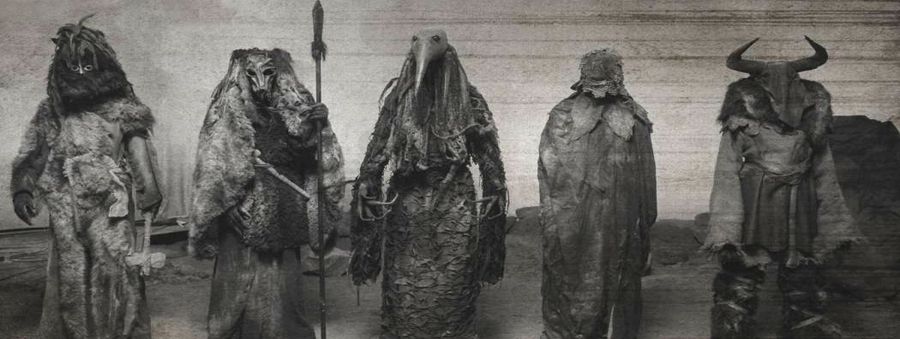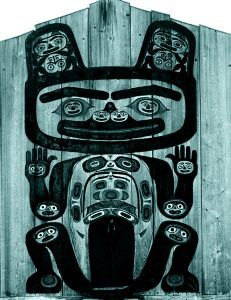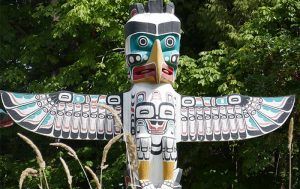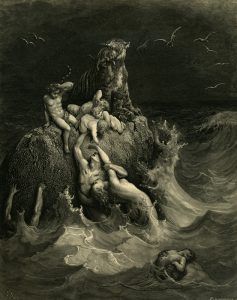Various Tribes’ Legends and Myths:
The Ark On Superstition Mountains
The Gift of Ehyophsta: A Cheyenne Legend Retold
The Hidden City of Death Valley
Little People of Wyoming & the Pedro Mountain Mummy
Native American Legends of Arizona
Navajo Skinwalkers – Witches of the Southwest
The Salt Witch of the Nebraska Plains
Teihiihan – The Little Cannibals of the Plains
The Thunderbird of Native Americans
Wendigo – Flesheater of the Forests
By Tribe:
Mythology & Sacred Concepts:
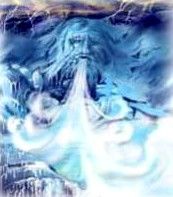
Native American Legends.
While a Great Spirit constitutes the basis of Indian theory, the tribes believe in multiple deities surrounded by mythology. In accordance with their views of nature and spirit, they constantly appeal to these powers at every step of their lives. They hear the Great Spirit in every wind; see him in every cloud; fear him in sounds, and adore him in every place that inspires awe. While cultures and customs varied among the tribes, they all believed the universe was bound together by spirits of natural life, including animals, water, plants, the sky, and the Earth itself.
Native American culture struggled to survive after the white man invaded their lives. Living through forced moves, war, starvation, diseases, and assimilation, these strong and spiritual people kept their many legends and stories alive. Passed down through the generations, these tales speak of timeless messages of peace, life, death, and harmony with nature.
The sacred beliefs of many tribes are largely formulated and expressed in sayings and narratives resembling the legends of European peoples. There are large collections of these tales and myths from the Blackfeet, Crow, Nez Perce, Assiniboine, Gros Ventre, Arapaho, Arikara, Pawnee, Omaha, Northern Shoshone, and others. In these, much interesting information can be found. Though each tribe has its own beliefs and sacred myths, many have much in common.
A deluge or flood myth is almost universal in the Plains tribes and the Woodland Indians. Almost everywhere, it takes the form of restoring the submerged earth by a more or less human being who sends down a diving bird or animal to obtain a little mud or sand. Other tales with common threads are the “Twin-heroes” – the Woman who married a star and bore a Hero” and the “Woman who married a Dog.” A star-born hero is found in myths of the Crow, Pawnee, Dakota, Arapaho, Kiowa, Gros Ventre, and Blackfeet. Indian mythologies often contain large groups of tales reciting the adventures of a distinguished mythical hero with supernatural attributes, who transforms and, in some instances, creates the world, who rights great wrongs, and corrects great evils, yet who often stoops to trivial and vulgar pranks. Among the Blackfeet, for instance, he appears under the name of Napiw, also called “Old Man.” He is distinctly human in form and name. The Gros Ventre, Cheyenne, Arapaho, Hidatsa, and Mandan have similar characters in their mythology.
The “Old Man” also appears in the mythologies of the adjoining cultural areas, such as the area between the Plains and the Pacific Ocean. Some tales appear similar but are attributed to an animal character with the name and attributes of a coyote. Under this name, he appears among the Crow, Nez Perce, and Shoshone on the western fringe of the Plains but rarely among the Pawnee, Arikara, and Dakota, and practically never among the tribes that designate him as human. This hero is given a spider-like character called Unktomi among the Assiniboine, Dakota, and Omaha.
In addition to heroes, many animal tales are to be found, which often explain the structural peculiarities of animals due to some accident. For example, the Blackfeet trickster, while in a rage, tried to pull the lynx asunder, causing it to have a long body and awkward legs. In other cases, the tales narrate an anecdote about the origin of life itself. In some tales, the ending includes how some aspect of life was “ordered to be,” explaining a natural phenomenon or mythical belief.
There are also tales in which supernatural beings appear as well-known animals and assist or grant favors to humans. In the mythology of the Plains tribes, the buffalo is a favorite character and is seldom encountered in the mythology of other areas. The bear, beaver, elk, eagle, owl, and snake are also frequently referred to, but also occur in the myths of Woodland and other tribes. Of imaginary creatures, the most conspicuous are the water monster and the Thunderbird. The former is usually an immense, horned serpent that lives underwater and fears thunder. The thunderbird is an eagle-like being that causes thunder.
Migration legends and those accounting for the origins and forms of tribal beliefs and institutions comprise a large portion of the mythology, formulating a concept of the religion and philosophy of various groups.
Compiled by Kathy Alexander/Legends of America, updated July 2025.
“In ages past, our old ones were the storytellers. This was the way things were passed along to the generations that followed. For this reason, the aged people made it a point to remember every detail so they could relate it at a later time. They were the word and picture carriers, making history and spiritual values alive and important. In recent times we have made our old ones think they are not so important. We spoof their stories and make them feel foolish. The truth is that we are ignorant of what is precious and how to ‘a da li he li tse di — appreciate age. Rigidity can creep in and set even the young mind if there are no soft memories, no laughter, no times too deep for tears. Age is grace — a time too valuable to waste.”
— Joyce Sequichie Hifler from her book A Cherokee Feast of Days
Also See:
Native American Proverbs & Wisdom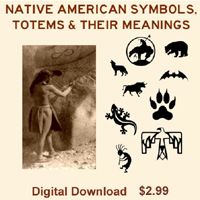
Native American Rituals and Ceremonies
The Role of Astronomy and Mythology In Native American Culture
See Sources.

